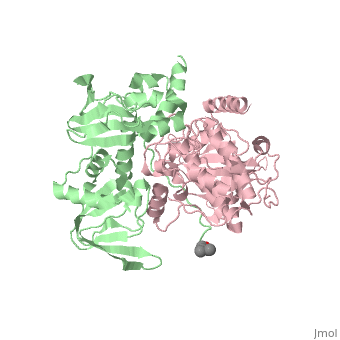Protein kinase A (PKA) is a group of enzymes whose activity is dependent on the concentration of cAMP, and is also known as cAMP-dependent protein kinase.
Function
Protein kinase A phosphorylates specific serine or threonine residues, which activates or deactivates the protein. Depending on the cell type, different proteins are available for phosphorylation. When activated with cAMP, PKA catalyzes the breakdown of glycogen, inhibits the synthesis of glucose, and promotes the increase of heart rate.In the "flight or fight" response, muscles become ready for action as a result of the activity of PKA. Overall, this enzyme helps regulate glucose levels,glycogen levels, sugar levels, and lipid metabolism.
See also CAMP-dependent pathway and CAMP is second messenger.
Structure
PKA consists of two types of subunits. It has a 49-kd (R) and a 38-kd (C). The R dimer contains two cAMP bindng domains and the pseudosubstrate sequence, Arg-Arg-Gly-Ala-Ile. The C subunit has two lobes. The larger lobe binds the peptide and contributes the key catalytic residues and the smaller lobe binds ATP-Mg2+. This shows a catalytic subunit with an inhibitor with a psuedosubstrate bound to the active site and an ATP bound to the adjacent active site. When PKA is enzymatically inactive (absence of cAMP), it is a heterotetrameric complex of a regulatory dimer bound to two catalytic subunits, forming the R2C2 complex. In its active state, the complex dissociates to form an R2 subunit and two C subunits. The C subunits are enzymatically active in itself and once released, are free to bind and phosphorylate available substrate proteins.
Mechanism
PKA consists of a regulatory dimer, which each regulatory subunit attached to a catalytic subunit. When cAMP levels are low, the enzyme is intact, forming the R2C2 complex. However, when cAMP levels are high, two cAMP molecules bind to the regulatory sites of the complex, which leads to the dissociation of the R2C2 complex into an R2 subunit and two C subunits. When cAMP binds to the R chains, the binding allosterically removes the sequences, Arg-Arg-Gly-Ala-Ile, out of the catalytic sites. This psuedosubstrate sequence of R occupies the catalytic site of C and prevents it from interacting with protein substrates. The only difference between the pseudosubstrate sequence and the sequence for phophorylations is the alanine in place of the serine. The pseudosubstrate binds to PKA through specific interactions. The guanidinium group of the first arginine forms an ion pair with the carboxylate groups of the glutamate residue, Glu 127, of the enzyme, forming a salt bridge. In the same way, the second arginine interacts with two other carboxylate groups, forming two more salt bridges. Two leucine residues of the enzyme form a hydrophobic groove in which the nonpolar side chain of isoleucine fits into. The scene is shown here. Once released, the two enzymatically active C subunites are free to phosphorylate proteins.
PKA is inactivated by a feedback mechanism. PKA activates phosphodiesterase, which converts cAMP back to ATP. This reduces the amount of cAMP that can activate PKA.
3D structures of protein kinase A
CAMP-dependent protein kinase

